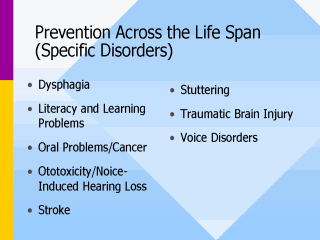 |
Resources
for Specific Disorder Categories: In each of the following disorders, there are
primary, secondary, and tertiary means of prevention the audiologist or speech-language
pathologist can implement. A. Dysphagia: (Secondary) Dysphagia screenings of high-risk
patients on admission to a health-care facility.
B. Literacy and Learning
Problems: (Primary) Providing young children with the necessary environmental stimuli
to enhance communication skills and literacy.
C. Oral Cancer: (Secondary) Oral
cancers account for more that 5% of all cancers in the United States. Early
detection and diagnosis of oral cancer to coordinate efforts and referrals for diagnosis
and treatment is a preventive measure.
D. Ototoxicity: (Primary) Medications
used to treat cancer have potential to cause damage to the structures of the inner ear.
Patient counseling regarding potential effects on the auditory system prior to drug
prescription is a primary or secondary means of prevention. Noice-Induced Hearing Loss:
(Secondary) Routine hearing screenings for individuals at risk for NIHL (e.g.
musicians, construction workers)
E. Stroke: (Tertiary) Stroke
is the number one cause of adult disability in the United States, often resulting in
communication disorders. Treatment of aphasia, apraxia, dysarthria,
cognitive-communication impairments, and dysphagia are examples of tertiary prevention
treated by a speech-language pathologist.
F. Stuttering: (Secondary)
Prevention begins with a thorough evaluation of communication demands in a child’s
motor, linguistic, emotional, and cognitive capacities.
G. Traumatic Brain Injury:
(Primary) Prevention programs targeted at decreasing the incidence of onset in
high-risk population is an example of primary prevention (e.g., high-risk parents for
child abuse, roadway safety).
H. Voice Disorders: (Primary) Encouragement
of healthy voice production through vocal hygiene programs.
Transition Point: At
certain ages, individuals are at higher risk for specific disorders... |
